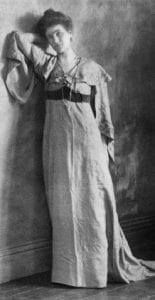Biography
by Anthony Domestico

May Sinclair (1863-1946) is one of the forgotten modernists. Close friends with Ezra Pound, Ford Madox Ford, Robert Frost, and others, Sinclair was the first British writer to praise T.S. Eliot’s Prufrock and Other Observations, the first critic to use the term “stream-of-consciousness” to describe a literary technique, and the creator of a powerful, formally experimental female Bildungsroman in Mary Olivier (1919). She primarily wrote novels of ideas, as her precocious female protagonists grappled with Greek philosophy, Spinoza, and Christian mysticism. Sinclair, who wrote numerous tracts on philosophical idealism and was well versed in Freudian psychology, stands at the intersection of art and intellectual life, of literature and philosophy.
Mary Amelia St. Clair was born in Rock Ferry, Chesire on August 24, 1863 to a religiously orthodox mother and a failing, alcoholic father. She briefly attended the Cheltenham Ladies College, but had to leave after a year to tend to her brothers, four of whom had a congenital heart defect that resulted in early death.
In her one year of formal education, Sinclair studied under Dorothea Beale and became interested in German philosophical idealism. She voraciously read T.H. Green, who revived this philosophical tradition in Britain, and this experience resulted in a spiritual crisis in 1886. Sinclair broke with her mother’s religious views, instead embracing a mystical idealism in which reality is seen as the manifestation of God’s consciousness, and consciousness is seen as the means to get in touch with divinity. Sinclair would write two books defending philosophical idealism: A Defence of Idealism (1917) and The New Idealism (1922).
Sinclair began writing professionally in 1896, publishing her first novel, Audrey Craven (1897), shortly thereafter. In 1904, she published The Divine Fire, a schematically philosophical novel that briefly resulted in her international celebrity. After the popular success of this effort and an attendant book tour in the United States, Sinclair drifted towards social realism in works like The Helpmate (1907) and Kitty Tailleur (1908).
In 1912, Sinclair met Henry James in London. This was the first of her many friendships with important figures in British modernism. She began writing for The Egoist, publishing a review of Dorothy Richardson’s novels in 1918 in which she described the “stream-of-consciousness” method of narration as a reflection of the subjectivist turn in philosophy. In 1914, Sinclair joined the Society for Psychical Research; she began to read Freud and Jung, becoming particularly fascinated by the ideas of sublimation and sexual repression.
These ideas – German idealism, formal experimentation as a signal of philosophical sophistication, Freudian psychology – began to crop up in Sinclair’s own fiction. Her 1919 Mary Olivier: A Life was her boldest, most impressive novel. In its use of second-person narration, its deliberate, almost sculptural patterning, and its attempt to represent the mind and language of a pre-verbal infant, the novel invites comparisons with James Joyce’s A Portrait of the Artist as a Young Man, published in The Egoist four years earlier. The Life and Death of Harriet Frean (1922) was a similar attempt at a modernist, female Bildungsroman.
In the early 1920s, Sinclair began to display signs of Parkinson’s disease. She moved to Buckinghamshire, where she lived until her death in 1946. Although currently neglected in modernist studies, Sinclair is a fascinating figure who was deeply immersed in the intellectual currents of her time.